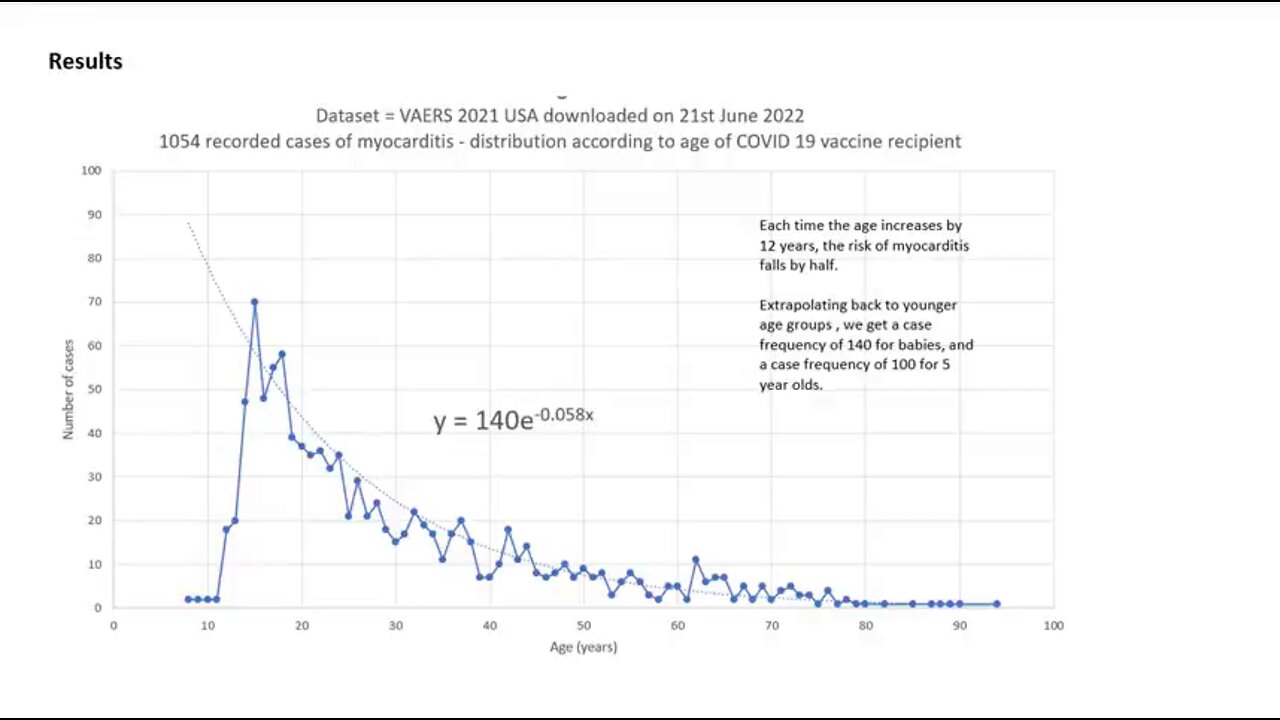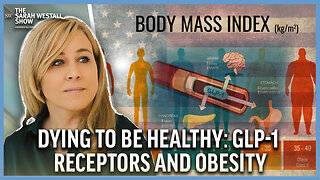Premium Only Content

Risk of Myocarditis in babies exposed to COVID-19 Vaccines | Craig Paardekooper
DESCRIPTION BY CRAIG PAARDEKOOPER
In this study, I downloaded the VAERS data for the whole of 2021, and counted the number of cases where myocarditis was mentioned as a symptom, and the age of each recipient.
There were a total of 1054 cases where the age of the recipient was provided.
Then I created a pivot table to count the number of cases of myocarditis for each age.
The graph shows an exponential decline of myocarditis with age for COVID 19 vaccine recipients. For every 12 years that passes, the risk of myocarditis falls by half.
This means that babies will have –
• 2 x the risk compared to 12 year-olds
• 4 x the risk compared to 24 year-olds
• 8 x the risk compared to 36 year-olds
• 16 x the risk compared to 48 year-olds
It was pointed out that I should take into account the different population sizes for each age group, since if a smaller population produced a high case rate of myocarditis, then this would greatly increase the calculated risk of myocarditis for that population. Since young people had only recently begun vaccination, I suspected that their population was less than older age groups who began vaccination earlier in the year. Consequently, I expected the risk of myocarditis to be even higher in the young than calculated above.
In order to compensate for population size effects, I divided the number of cases for each age group by the total number of records (all adverse reactions) for that age group in VAERS.
The resulting graph shows that the risk of myocarditis starts jumping up to a very high level as age decreases. A very rough approximation is that myocarditis is halved for every 8 years that age increases. But we will need to take a closer look in order to calculate the incidence of myocarditis in babies.
Calculating the Incidence of Myocarditis for Babies
The incidence of myocarditis for babies would be the incidence at year 0, so I would need to extrapolate the graph backwards to see where it cuts the y-axis. As you can see, the graph is shooting up quite rapidly as age decreases, so I decided to create a log graph instead to better estimate the point of intersection.
It looks as if the point of intersection is at 10 3.1217 = 1323. This means that the estimated rate of myocarditis in babies following COVID-19 vaccination is 1323 cases per 100,000 = 7.43 times the rate for 15 year-olds (which was 178 cases per 100,000).
Of course, VAERS is under-reporting by an order of magnitude, but this calculation tells us that babies will get myocarditis 7.43 x more than adolescents.
The Thailand Study
The Thailand myocarditis study (Cardiovascular Effects of the BNT162b2 mRNA COVID-19 Vaccine in Adolescents[v1] | Preprints) found 7 cases of myocarditis in 301 adolescent subjects – a rate of 1 in 43 or 2.3%. Therefore, the incidence of myocarditis in babies will be 7.43 x this = 17%. So 1 in 6 babies exposed to the COVID-19 vaccine will get myocarditis.
You can find my full report at https://t.me/CovidScienceLibrary/868 or at
-
 1:14:34
1:14:34
Michael Franzese
15 hours agoWhat's Behind Biden's Shocking Death Row Pardons?
82.7K49 -
 9:49
9:49
Tundra Tactical
14 hours ago $25.32 earnedThe Best Tundra Clips from 2024 Part 1.
138K11 -
 1:05:19
1:05:19
Sarah Westall
14 hours agoDying to Be Thin: Ozempic & Obesity, Shedding Massive Weight Safely Using GLP-1 Receptors, Dr. Kazer
118K32 -
 54:38
54:38
LFA TV
1 day agoThe Resistance Is Gone | Trumpet Daily 12.26.24 7PM EST
80.3K12 -
 58:14
58:14
theDaily302
23 hours agoThe Daily 302- Tim Ballard
75.2K13 -
 13:22
13:22
Stephen Gardner
17 hours ago🔥You'll NEVER Believe what Trump wants NOW!!
123K348 -
 54:56
54:56
Digital Social Hour
1 day ago $13.32 earnedDOGE, Deep State, Drones & Charlie Kirk | Donald Trump Jr.
70.5K6 -
 DVR
DVR
The Trish Regan Show
18 hours agoTrump‘s FCC Targets Disney CEO Bob Iger Over ABC News Alleged Misconduct
73.8K44 -
 1:48:19
1:48:19
The Quartering
19 hours agoElon Calls White People Dumb, Vivek Calls American's Lazy & Why Modern Christmas Movies Suck!
153K115 -
 2:08:42
2:08:42
The Dilley Show
20 hours ago $38.02 earnedH1B Visa Debate, Culture and More! w/Author Brenden Dilley 12/26/2024
130K44